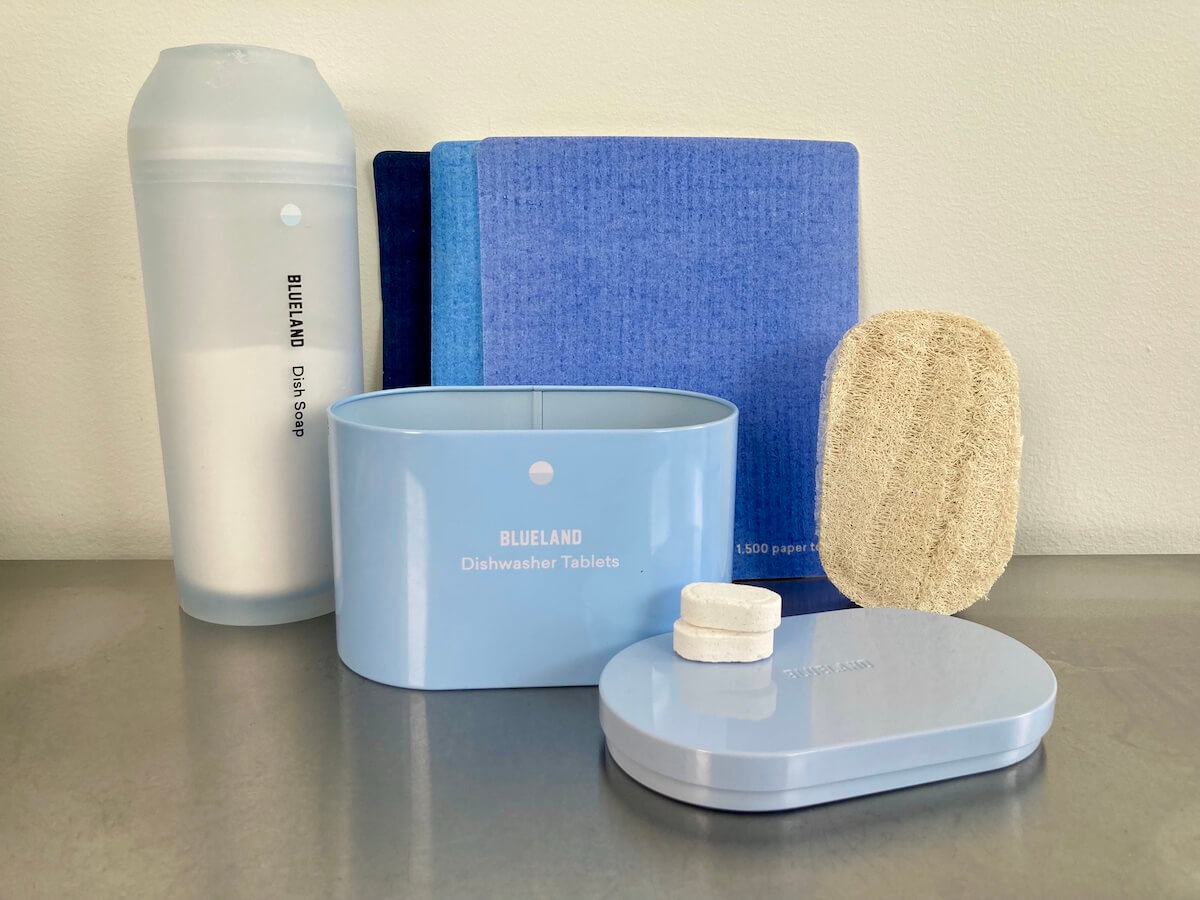I’m on a Blueland kick lately, replacing conventional cleaning products with plant-based ones from the B-Corp. The first products of theirs I tried were for the bathroom. (Spray cleaner reviewed here, toilet bowl cleaner reviewed here.) Now I’m moving on to the kitchen. Here’s my honest review of Blueland’s dish cleaning products.
Blueland gifted these products to me and this post contains affiliate links. If you shop through my links, I may earn a commission. As always, all opinions are my own and I only write about items that interest me. Thanks for the support.
Dishwasher Tablets

Dishwasher Tablets: Starter set with tin – $20-$25 // Refill of 60 tabs – $18.90-$21
Earlier this year, I went on a search for a more eco-friendly dishwasher detergent after ditching pods, which are encased in PVA, a synthetic plastic polymer. A study (partly funded by Blueland) found that while PVA is supposed to dissolve in water, pod encasements often don’t break down and pollute our waterways.
Blueland makes a plastic-free dishwasher tablet. I didn’t try it at the time of my initial search because the Wirecutter gave it middling marks, saying, “The tabs are softer than competitors, and pieces broke off when we handled them. These tabs were also worse cleaners than others we tested.”
But I couldn’t say no when Blueland offered to send me some to try. And you know what, I don’t know what the Wirecutter is talking about. Because over here in my dishwasher, they perform just fine. And none of the tabs I’ve handled have broken.
The powder dishwasher detergent I’m using is cheaper than the Blueland tablets, which cost 32 cents each (and that’s with a subscription). But if you’re looking for that pod-like form factor without the plastic, I recommend these.
Powder Dish Soap

Dish Soap: Starter set with dispenser – $14.40-$18 // Refill – $10.80-$12 // Sponges – $12.60-$14 for 3
I was intrigued by the idea of Blueland’s powder dish soap. But this didn’t hit the mark for me. In terms of cleaning power, I don’t have any complaints there. It suds up nicely and it cleans my dishes.
My main quibble — and perhaps this is user error — is that no matter how gently I dispense the powder from the container, powder seems to linger in the air. I can tell because I start coughing or my nose gets irritated.
Obviously, inhaling powder is no good. Maybe I need to adjust my technique. But I’m inclined to keep using liquid dish soap.

How much dish powder to use? I’m not sure. This much looks good.
BTW, filling the dispenser was not intuitive for me. It’s a substantial feeling container with a rubbery feel for grip. But I could not figure out how to get it open! After struggling for a while, I had to Google for the instructions. Here’s the trick: you squeeze the body of the container to remove the lid.
View this post on Instagram
Scrub Sponge

Scrub Sponge – $12.60 – $14 for 3
Let’s talk about the cleaning accessories. First, sponges. I’ve been looking for a plastic-free sponge for washing dishes. A good one is surprisingly hard to find! For a while, I tried a silicone sponge, but it didn’t suds up and I like a good sudsing when hand washing dishes.
Lately, I’ve been using Full Circle’s In a Nutshell scrubby sponges, which combine walnut shells with cellulose. (I like the brand in general and have reviewed some of their cleaning supplies.) But, like similarly-constructed sponges from Public Goods and Grove Collaborative they still contain plastic fibers on the scrubbing side.
The Blueland sponge combines loofah with cellulose. The scrubby loofah part is sewn onto the base with cotton thread. As far as performance, it works well for lighter cleaning. But when it comes to more difficult tasks — think baked-on food residue on baking trays — the part-plastic sponges perform better. The loofah simply isn’t tough enough.

The Blueland sponge suds up nicely. But it’s not tough enough for difficult jobs.
So, while I like it, it doesn’t check all the boxes for me. So far, though, it’s the best plastic-free sponge that I’ve tried. The stitching has held up well (which was not the case with another brand I tried.)
Cloud Cloth

Cloud Cloth – $12.60-$14 for 3

The Cloud Cloths come in three shades of blue and soften into cleaning mode with water.
Compostable reusable cloths that are meant to replace paper towels are not new to me. These spongey cloths (also known as Swedish dish cloths) come in rigid sheets, but when you wet them, they become pliable cloths. I’ve been using reusable sponge cloths from If You Care. But there are lots of options out there from many brands, including Swedish Wholesale, Three Bluebirds, Papaya, Who Gives a Crap, and many others. I even picked some up from Ikea once.
How interesting could Blueland’s version be? Well, even though it looks just as thin as other brands in its dry state, when in cleaning mode, it feels a bit thicker and cushier. This makes for a nicer hand feel (and maybe even more absorbency). These cloths can go in the dishwasher too when they need a cleaning themselves.
Overall, these Blueland dishwashing products were mostly a success. I liked three out of the four items I tried.



